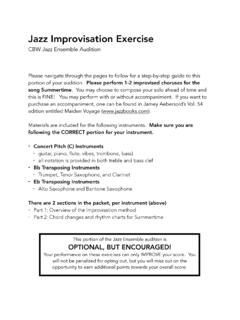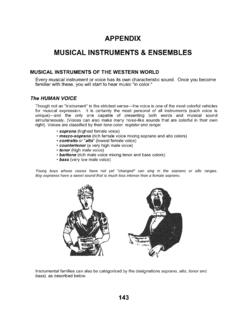Transcription of The Circle of Fifths is that magical musical master tool.
1 The Circle of Fifths is a mystery to many. But what if you found everything you ever needed to know and learn about musical pitch (every note, scale, chord, progressions, etc.) in a simple diagram that could fit in the palm of your hand? The Circle of Fifths is that magical musical master tool. This learning device has endured for hundreds of years since its invention, and for good reason; there s no need to reinvent the wheel. Or, apparently, any other circular entity. This incredibly powerful tool will take you far beyond simply understanding music theory - it will help you write music, predict chords in a progression, and understand relationships between major and minor keys.
2 Is the Circle of Fifths for You? Though the Circle of Fifths is most commonly understood as a component of classical music theory, it s certainly not only for the hallowed halls of the conservatory. It s a valuable tool for any musician of any musical background. Our guide is the Circle of Fifths made easy very little prior musical knowledge is required, but by the end of this article, you ll not only understand the mechanics behind the Circle , but also how to apply it in music theory, transposition, singing, songwriting, and more.
3 This incredibly powerful tool will take you far beyond simply understanding music theory it will help you write music, predict chords in a progression, and understand relationships between major and minor keys. It will serve you well, regardless of whether you are a classical violinist, jazz saxophone player, a bassist in a rock band, or aspiring DJ. 1 Copyright musical U, So fasten your seatbelt: we re diving deep into this infinite pool of musical wisdom. So, here is the Circle of Fifths , explained. 2 Copyright musical U, TABLE OF CONTENTS Is the Circle of Fifths for You?
4 1 The Circle s Beginnings4 Let s Start With Some The Keys to What?5 What s a fifth ?6 Build Your Own Perfection:8 The Circle of Fifths !10 The Bare Bones10 Figuring Out Key Signatures12 Sidebar: Where Things Get A Bit What About Minor Keys?15 Also Known Modes and the Circle of Fifths17 How to Use the Circle of Fifths20 Using the Circle of Fifths to find Key Signatures20 Using the Circle of Fifths to Build Scales21 Read scales right off the Circle21 Using the Circle of Fifths to Build Chords22 Major and Minor Chords22 Dominant Seventh Chords26 Using the Circle of Fifths to Play Chord Progressions By Ear30 The Circle of Fifths for Songwriters32 Crossing the Circle34 Beyond The Key that Unlocks the World of Western Music35 3 Copyright musical U.
5 The Circle s Beginnings So, how was the Circle of Fifths invented, and who is responsible for the discovery of this musical godsend? Russian composer and music theorist Nikolay Diletsky set this whole wheel rolling in the late 1670 s. He intended his book Grammatika as a guide to composition, but with the rules of music theory in mind: 4 Copyright musical U, Since then, it has been expanded and improved-upon to yield the comprehensive circular diagram we have today. Let s Start With Some Before we dive into the mechanics of the Circle , let s first understand some key concepts.
6 Bear with us - this basic music theory will be a huge help in making sense of the Circle . Each station on the Circle represents a note , a chord , and a key . The Keys to What? Let s begin by answering the question: What s a key? In music, we define a key as the tonal center of a piece of music. The melody and harmony will revolve around this tonal center, which is simply a single note. This single note is also given the name of the tonic , and is given the scale degree designation I . It is on this tonic that we build the scale , or the eight-note sequence that is used to compose melodies and harmonies in the key of the tonic.
7 The most commonly-encountered types of scales in Western music are called major and minor . To retain the characteristic major or minor sound, scales in most keys require accidentals - sharps and flats that will give the scale the desired sound. 5 Copyright musical U, Each key will have its unique pattern of sharps and flats. However, if you examine the distances (known as intervals ) between the notes of, say, every major scale and compare them, you will see that the interval pattern is exactly the same in all major scales.
8 Learn more about intervals . What s a fifth ? One of these shared intervals will be a fifth (also known as a perfect fifth ). So what s so perfect about a fifth ? Perfect intervals vibrate in pure mathematical ratios. For example, this note (A) is vibrating at 440 Hz (cycles per second): LISTEN ONLINE And this A is vibrating twice as fast, at 880 Hz: LISTEN ONLINE We call this interval a perfect octave . Octaves relate to each other in some multiple of a 2:1 ratio. Octaves are so perfect that, when played together, the notes blend together until it s difficult to tell one from the other: 6 Copyright musical U, LISTEN ONLINE The next smallest simple ratio is 3:2: LISTEN ONLINE You can hear that the fifth also blends very well, and has a powerful, resonant sound (which is how the famous guitar power chords work.)
9 So when you put your finger on the 12th fret of a guitar, you re splitting that string in half (2:1 ratio). To produce the fifth , divide the string in three parts (7th fret). The perfect fifth interval is said to be consonant , meaning it is a typical pleasant sound and sounds stable within music. The fifth of a key can be found by finding the fifth degree of the scale of the key. If you are familiar with tones and semitones, the fifth can be found by counting seven semitones up . Starting at the tonic, this is seven adjacent keys (this includes black keys!)
10 On piano, or seven frets up on the guitar, bass, and ukulele. Playing a fretless string instrument? Have no fear! The Circle of Fifths also applies to the violin and its immediate family of instruments. The fifth shows up frequently in basslines of Western music, with root- fifth patterns being a popular choice for bassists. Why? 7 Copyright musical U, The perfect fifth interval sounds consonant and stable, thereby helping the bassist fulfill their role of supporting the song; the patterns of this interval sound great under guitar chords.



